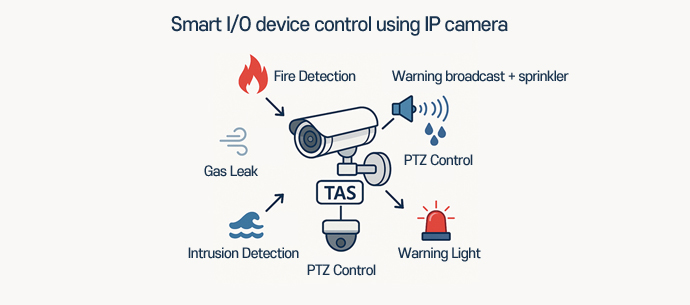News
We will be a company that connects the world as one.

News Letter
Smart I/O device control using IP camera
2025.06.11 09:32
In this newsletter, we are pleased to introduce SeyeonTech’s proprietary I/O control functionality, which is uniquely built into our IP cameras, along with the automated control system it enables.
As AI technology becomes increasingly integrated into camera systems, the need to connect with various IoT devices has grown rapidly. In real-world CCTV installations, it is often necessary to link various sensors (input devices) with alarm or response equipment (output devices) to enable automated responses to specific events. However, traditional system architectures require cooperation from NVR or VMS vendors for such integrations. In many cases, these integrations are difficult to customize, costly, and time-consuming. Furthermore, creating flexible N:N control scenarios between multiple input and output devices typically requires additional software development, posing practical limitations.
To address these challenges, SeyeonTech has embedded direct I/O integration functionality into its IP cameras. Without the need for external software or control platforms, our cameras can autonomously execute complex actions. For instance, when a fire alarm is triggered, the camera can automatically broadcast a warning message and activate a sprinkler system. When rising water levels are detected, it can initiate a broadcast and simultaneously move a PTZ camera to a preset position. Similarly, in the event of an intrusion, the camera can turn on warning lights, or if gas concentration exceeds a threshold, both a siren and a voice warning can be triggered—all from the camera itself.
SeyeonTech IP cameras utilize motion detection and AI-based video analytics as input triggers, while external devices can be controlled through the camera’s Digital Output (DO) port. The camera can also play pre-recorded voice messages based on event conditions, control third-party PTZ cameras to move to preset locations, and call HTTP URLs to interface with external systems.
Additionally, the camera includes a built-in RS-485 port, which supports direct integration with a wide range of industrial sensors and control devices using the MODBUS protocol. Up to 247 devices can be connected through a single RS-485 bus, including relays, switches, temperature sensors, water level detectors, gas sensors, and more. In this architecture, the SeyeonTech camera acts as the MODBUS Master, allowing it to read statuses and send commands to connected MODBUS slave devices.
The camera also functions as a MODBUS TCP Gateway, enabling external systems to remotely connect and control I/O devices or monitor their status. This advanced communication capability is rarely found in conventional CCTV systems.

All of these functions are operated through SeyeonTech’s proprietary technology, the Trigger Action Service (TAS). TAS is a condition-based automation system that executes predefined output actions when specified input conditions—such as sensor states, AI results, or schedules—are met. Without requiring additional software development, users can easily define and implement complex control scenarios. One key advantage is that events triggered by one camera can control actions on other cameras, such as activating warning lights, moving PTZ positions, or playing voice messages—enabling cross-camera coordination and automation.
SeyeonTech’s TAS is a patented core technology and is a truly unique feature not found in other IP cameras currently on the market. It delivers exceptional efficiency and reliability in environments where real-time response is critical, such as disaster response, security surveillance, and industrial automation
Download: http://flexwatch.com/51/80?sca=Document




 이전글
이전글
 다음글
다음글


